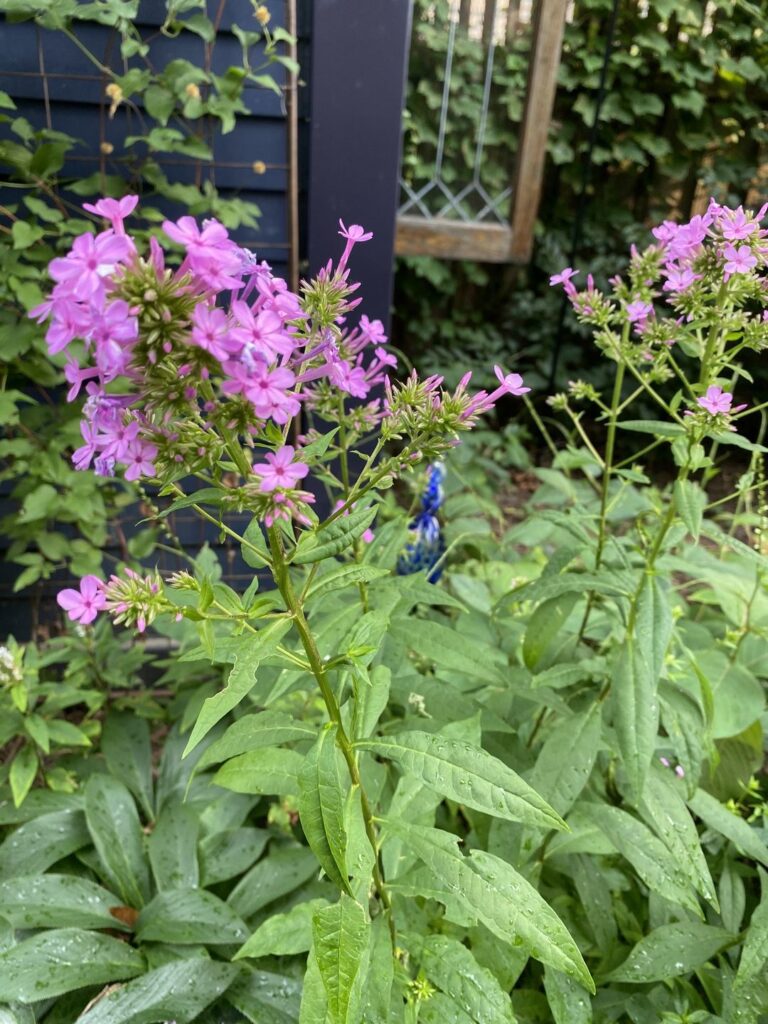Solidifying my list of natives this morning, in preparation for the native garden walk on Saturday. (Details here: https://westcook.wildones.org/events-calendar/…)
Many of the plants I have are cultivars, not straight natives, like “Jeana” pictured below. Purists may want to stick to just natives, but some cultivars offer just as much benefit to pollinators as the original natives. (Some don’t.) My garden has quite a few non-natives too, so it’ll be interesting to see how people on the native garden walk respond to it. It’s really a hybrid garden.
“This cultivar was discovered growing along the Harpeth River near Nashville, Tennessee and named after its discoverer, Jeana Prewitt. Although there were many plants of Phlox paniculata in the area, ‘Jeana’ in particular stood out for its exceptionally mildew-free foliage. This trait carries through to the garden and is one of the main reasons ‘Jeana’ performed so well in the trial. This 5′ tall beauty also produces an impressive floral display from mid-July through early September. Interestingly, the individual flowers, or pips, are much smaller than any other garden phlox. However, that does not deter the butterflies that feed on its nectar. In fact, we found ‘Jeana’ attracted more butterflies than any other garden phlox in the entire trial. With a top rank in both horticultural and ecological evaluations, Phlox paniculata ‘Jeana’ is hard to beat.” — https://mtcubacenter.org/…/phlo…/phlox-paniculata-jeana/
July:
Short
- Butterflyweed (Asclepius tuberosa) – started in mid-June
- Purple poppy mallow (Callirhoe involucrata) / Wine cups – reddish-pink (started in mid-June)
- Rough Blazing Star (Liatris aspera) – white
- Wild Petunia (Humilia ruellis) – purple
Medium
- ‘Little Joe’(Eupatorium dubium) – dwarf cultivar of Joe Pye Weed
- Morningstar sedge (Carex grayi) / Gray’s sedge – green
- Starry Campion / Widow’s Frill (Silene stellata) – white
- Swamp Milkweed (Asclepias incarnata) – “Ice Ballet” white, also pink (started in mid-June)
- Turtlehead (Chelone)
- Winged Loosestrife (Lythrum alatum) – pink
Tall
- Bee Balm (Monarda fistulosa) – pale purple
- Cardinal Flower (Lobelia cardinalis)
- Common Milkweed (Asclepius syriaca)
- Coneflower (Echinacea purpurea) (pink)
- Culver’s Root (Veronicastrum virginicum) – white, pale purple
- Dense Blazing Star (Liatris spicata)
- Fairy Candles (Actaea racemosa), aka Bugbane, Black Cohosh
- Garden Phlox (Phlox paniculata) (white, pale pink, or pinkish-purple) – “David,” “Jeana” cultivars
- Goldenrod (Solidago)
- Great Blue Lobelia (Lobelia siphilicata)
- Pale Purple Coneflower (Echinacea pallida)
- Swamp Rose Mallow (Hibiscus moscheutos)
Very Tall
- Joe Pye Weed (Eutrochium purpureum) – pink
- Queen of the Prairie (Filipendula rubra) – just planted, should get to 5’ tall) – pink
- Serviceberry tree (Amelanchier arborea) – fruited
June:
- Indian pink (Spigelia marilandica)
- Spiderwort (Tradescantia) – deep blue, purple
- Whorled tickseed (Coreopsis verticillata) – blooms though August
May:
- Columbine (Aquilegia canadensis)
- Early coreopsis / Tickseed (Coreopsis auriculata) – keeps blooming lightly ‘til fall
- Eastern bluestar (Amsonia tabernaemontana)
- Foamflower (Tiarella cordifolia) – not native to IL, but native to neighboring states
- Greater creeping spearwort (Ranunculus flammula) – keeps blooming ‘til fall
- Purple meadow rue (Thalictrum dayscarpum) – blooms white, oddly
- Wild hyacinth (Camassia scilloides)
- Wild Indigo (Baptisia australis)
April:
- Double bloodroot (Sanguinaria canadensis)
- Great white trillium (Trillium grandiflorum)
- Purple Prairie Trillium (Trillium recurvatum)
- Shooting stars (Dodecatheon meadia)
- Virginia bluebells (Mertensia virginica)
- Wild geranium (Geranium maculatum)

